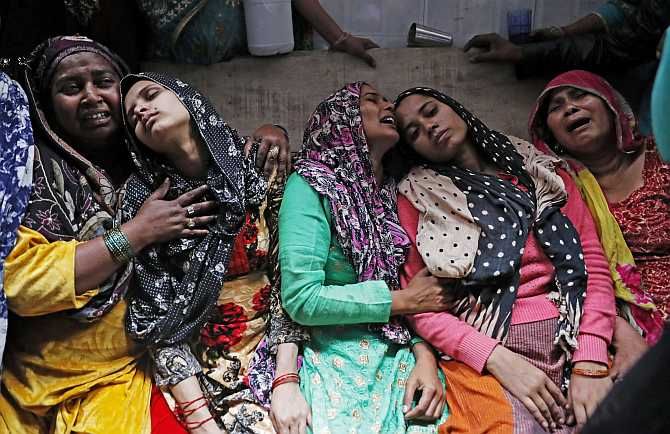Delhi was just one riot.
Add Bengal, Assam, Uttar Pradesh and you can count a few scores dead.
It could, regrettably, be just the beginning of a very long, dark phase for India, notes Shekhar Gupta.

The death toll has crossed 50, making it the highest ever in a Hindu-Muslim riot in Delhi's post-Partition history?
This, in India's most protected city, in an arc between 6 and 10 km of Rashtrapati Bhavan, where the glory of the Republic sits, flanked by South and North Blocks housing the entire and humongously formidable homeland and military security machinery built to protect it, and its people.
Any debate on a strife, mass dissatisfaction, insurgency, or terrorism usually stalls when it runs into a wall: The root-cause theory.
Antagonists invariably take inflexible, ossified positions for or against it, and nothing moves.
Watch Pakistan invoke it on cross-border terrorism and India's response, for example.
There are also risks in raising uncomfortable questions.
A minister or an army of social media 'influencers' could rise to charge you with anything they wish, from instigation to sedition and, for all you know, a court will also issue you notice.
That's the reason television channels were issued dire warnings to abide by the broadcast code, of course, after the damage had been done.
We are so chastened and quaking in fear, therefore, that we aren't fighting with the government for now for failing their citizens living just 6 km away from them.
We aren't, however, so cowardly yet that we won't pick an argument with another institution which failed the same citizens.
And in its case, the distance from the victims is even less, just 5 km.
This, mind you, isn't a case of complicity, incompetence, or ideology, the charges we usually throw at governments.
It is a misapplication of mind, a waste of institutional and moral capital of the one institution that matters when the chips are down, the last goalkeeper.
The root causes to the burning and humiliation of Delhi, of the many fires that are smouldering across the country, lie in the one institution which should have known better.
Surely, the wisest and most respected men and women chosen to run the Supreme Court can't be so oblivious of the inevitability of unintended consequences.
The CAA-NPR-NRC poison currently toxifying India, unfortunately, comes from a creeper bush planted by the Supreme Court of India when a Bench of Justices Ranjan Gogoi and Rohinton Nariman passed that landmark order to begin the NRC process in Assam, under its direct supervision.
In fairness, we should underline that this wasn't a sudden brainwave on the part of the judges.
There is a 'foreign nationals' issue peculiar to Assam and its messy history of immigration.
A massively popular movement against it had paralysed the state in the early 1980s, to the extent that the government's writ did not run for more than three years.
To such an extent that it was unable to even ensure that a drop of crude oil produced by Assam's oil fields could reach the 'mainland' refineries.
The anger -- that Bengali-speaking 'infiltrators' (the term originated there) were overwhelming indigenous culture, political power, and economics -- was near unanimous among ethnic Assamese.
As it invariably happens in such situations, the largely peaceful movement grew some nasty, militant offshoots as well.
Peace and normalcy were restored in the winter of 1985, after Rajiv Gandhi, then prime minister, signed an accord with the agitation leaders.
Among its many clauses was one promising a thorough NRC scrutiny, identifying illegal foreign nationals and deleting their names from electoral roles to begin with, and then deportation.
Again, because the specific context was Assam, there was a cut-off date -- March 25, 1971 -- when the Pakistani army's crackdown on what was then East Pakistan began.
The idea was what is familiar again now: Millions of Hindus had left East Pakistan to escape persecution for Assam since 1947.
They deserved refuge in India.
To simplify things, anyone who came in until it was Pakistan was to be left unquestioned, unsuspected, and untouched.
After March 25, 1971, the responsibility of looking after the Hindu minority was that of the friendly Bangladesh government.
It follows, therefore, that anyone who came in after that cut-off date was an illegal foreigner and would be sent back and Bangladesh was committed to resettle them -- anyone, Muslim or Hindu.
That accord made no such distinction.
Certainly, it wasn't also the judges's intention to make one.
The Bench was ruling on a petition seeking the implementation of this key clause of the Accord that all its signatories had conveniently forgotten.
You can take a purely legal view and ask, quite justifiably, why the judges should let the sleeping dogs lie just because it may be politically and pragmatically expedient?
The rest is a recent flashback and we can run it in fast-forward.
The NRC process began, supervised and expedited by a Supreme Court Bench, with a zeal matching that of the apex court's epochal cricket Bench.
I dare say, with about similar results in the end.
Except that one became a joke, the other is a tragedy.
The court had the head of the NRC process report to it directly, and put a gag on him so he couldn't speak to anyone, including the media.
This gave the process an aura of fear and opacity.
It also ordered that massive detention centres to house those found to be illegal be constructed.
And then, when the truth emerged, everything changed.
Some were furious with what the facts brought, but others more powerful saw an opportunity.
First of all, the 'foreigners' identified were a fraction of the old popular fantasy.
Then, more than two-thirds of those still not proven legal are Hindu Bengalis.
The ethnic Assamese won't accept the Hindus, nor would the logic of the 1985 Accord or the Supreme Court order to implement it.
And could the BJP ever expel the Hindus?
Where do we stand now? The BJP spotted an opportunity.
The Hindu 'infiltrators' of Assam could be protected with the new CAA and Muslims dealt with.
And now that the highest court had legitimised it for one state and also written a diabolical chronology and playbook, right up to detention centres, why not take it across the nation? It was an all-conquering polarising dog-whistle.
That's where we stand now.
A new ball, the Constitutionality of the CAA, is bouncing in the same court.
Meanwhile, the poison ivy it sowed with the best of intentions is creeping on India.
Even in Assam, the BJP government now says it's unhappy with the NRC and intends to do it all over again.
The officer who led it, directly under the court's supervision and protection, is being hounded.
Probably because he didn't bring the 'right' numbers.
So far, we haven't seen the Supreme Court defend what was done under its own watch, to say it won't allow a repeat NRC in Assam, or gross undermining of its own intention through the CAA.
Delhi was just one riot.
Add Bengal, Assam, Uttar Pradesh and you can count a few scores dead.
It could, regrettably, be just the beginning of a very long, dark phase for India.
That's why the time to reflect on the root cause is now.
By special arrangement with The Print











